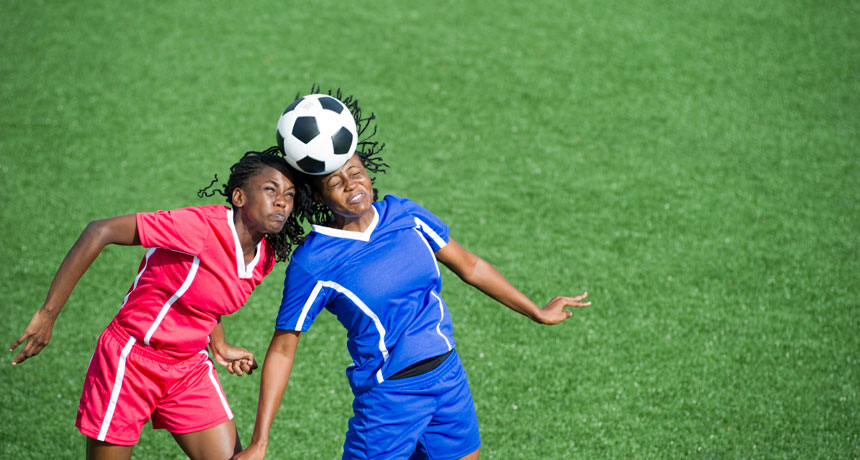Soccer: Watch out for collisions!
Heading the ball can lead to concussions, but it’s not the most common source of these brain injuries

Although heading the ball can lead to concussion, new research reveals that brain injury most often occurs through player-to-player contact, including contact during headers.
isitsharp/iStock photo
The biggest rule in soccer: no using arms and hands. So as a ball sails through the air, the easiest way a player may have to change the ball’s direction is by using his or her head. Those “headers,” however, can cause concussions, a type of brain injury.
Several sports organizations support banning headers from soccer games played by younger athletes — those not yet in high school. But researchers at the University of Colorado in Denver now report finding that headers are not the main problem. Most concussions that occur while playing soccer stem from aggressive play — bodies colliding with other bodies.
Epidemiologist Dawn Comstock led the study. It appeared July 13 in JAMA Pediatrics. (An epidemiologist investigates what’s behind a class of injuries or the spread of some disease.)
Comstock and her team analyzed data from the High School RIO (an acronym for Reporting Information Online). This website tracks sports injuries among U.S. high school athletes. Last year, Comstock’s group performed a similar analysis of teen lacrosse injuries. Now they’ve focused on the more than 600,000 soccer concussions reported by athletic trainers between 2005 and 2014.
FOR THE WIN Soccer fans voted this 2011 header by Abby Wambach the best goal in the Women’s World Cup. Headers are useful for redirecting the ball but can lead to concussion, particularly among teens, a new study finds. FIFATV/YouTube |
Some of the injuries (17 percent in boys and 29 percent in girls) were caused by contact with the ball or another piece of equipment. Others concussions occurred when a player hit the ground (13.3 percent of boys and 19.2 percent of girls). But collisions between two players accounted for 68.6 percent of brain injuries in boys and 51.3 percent of those in girls.
The researchers also looked at just those concussions due to heading — or attempting to head — the ball. Among boys, 30.6 percent of the concussions occurred this way. Among girls, 25.3 percent did. But only a small percentage of such injuries occurred simply from the ball contacting the head. More than half of concussions during headers resulted when two players collided.
Most concussions from headers happen during games, Comstock reports. That’s because two players may try to head the ball at the same time. Such “contested” headers rarely happen during practices, she points out. It’s aggressive play — not headers alone — behind most injuries, her team now concludes.
Soccer-related concussions also have become more common in recent years, Comstock notes. That reflects an increasingly aggressive culture of play. The best solution to reducing brain injury may not be banning headers, she says. Enforcing rules and preventing the collisions responsible for most concussions could be more effective.
These are tremendously valuable findings, says Andrew Lincoln. An epidemiologist at the MedStar Health Research Institute in Baltimore, Md., he was not involved with the research. The new findings provide a wake-up call that soccer officials need to improve safety, he says. And these changes can be instituted without making big changes to the way the game is played, he adds. “As we’re seeing in other sports, such changes can be made to improve player health and safety and still maintain the essence of the game.”
Power Words
(for more about Power Words, click here)
concussion Temporary unconsciousness, or headache, dizziness or forgetfulness due to a severe blow to the head.
culture (in social science) The sum total of typical behaviors and social practices of a related group of people (such as a tribe or nation). Their culture includes their beliefs, values, and the symbols that they accept and or use. These will be passed along from adults to children.
epidemiologist Like health detectives, these researchers figure out what causes a particular illness and how to limit its spread.







